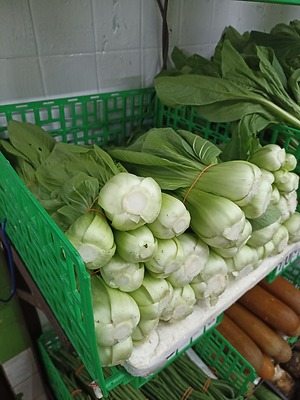


Pac Choi
Estimated Inventory, 20 lbs : 0
Description/Taste
Pac choi has curved, thick stems connected to oval-shaped leaves, averaging 20-25 centimeters in length, and are loosely clustered to a bulbous base. The firm stems range in color from white to pale green, depending on the variety, and are crunchy with a slightly fibrous texture. Connected to the stems, the dark to pale green leaves are crisp, glossy, and pliable with prominent white veining extending across the surface. Both the leaves and stems are edible, and Pac choi has a crisp, chewy consistency when raw with a green, sweet, and mustard-like taste. When Pac choi is cooked, it develops a tender texture and the flavor mellows to a taste similar to common cabbage and spinach.
Seasons/Availability
Pac choi is available year-round, with a peak season in the spring and fall.
Current Facts
Pac choi, botanically classified as Brassica rapa var. chinensis, is a non-heading Chinese cabbage that is a member of the Brassicaceae or mustard family. Also known as Pak choi, Bok choy, Bok choi, and Bai cai, Pac choi is known by many different names due to varying Asian dialects and varieties. Pac choi is a common spelling used in Europe and South Africa, and there are over twenty different varieties grown globally. Considered to be one of the oldest cultivated vegetables in the world, Pac choi is a well-known ingredient used in Asian cuisine that has established worldwide notoriety. The leafy cabbage is favored for its high nutritional properties, commonly incorporated into both hot and cold dishes, and is used as an all-purpose vegetable adding fresh, umami-like flavors to dishes.
Nutritional Value
Pac choi is an excellent source of vitamins A and C, which are antioxidants that can help protect the immune system and repair cell damage. It also contains vitamins B6, K, and E, magnesium, potassium, iron, manganese, and calcium.
Applications
Pac choi is best suited for both raw and cooked applications such as steaming, boiling, grilling, braising, and sautéing. When raw, the stems and leaves have a mildly pungent, mustard-like flavor that is suitable for fresh salads and slaws. The stems can also be used as a crunchy vessel for dips and spreads on appetizer platters. Pac choi is mainly associated with Asian cuisine and can be finely chopped and stuffed into dumplings or fresh spring rolls, halved or quartered into soups, braised and mixed into noodle dishes, lightly stir-fried and served as an accompaniment to cooked meats, or pickled for extended use. In Asia, Pac choi is also often finished with sauces composed of oyster, soy, or hoisin sauce mixed with other ingredients such as sugar, garlic, chicken broth, or sesame oil. In addition to Asian cuisine, chefs are modernizing Pac choi and are including it in other dishes such as grilling and topping with parmesan cheese, pairing it in fresh salads with ingredients such as mint and apricot, mixing into pasta dishes such as pumpkin gnocchi, or incorporating into grain bowls with other roasted vegetables. Pac choi pairs well with mushrooms, carrots, bell peppers, garlic, ginger, citrus, tofu, and meats such as fish, pork, duck, and poultry. The leaves and stems will keep up to one week when loosely stored in a plastic bag and kept in the crisper drawer of the refrigerator.
Ethnic/Cultural Info
Pac choi is traditionally consumed during Chinese New Year celebrations, which is an annual holiday that marks the new moon in January or February. Believed to represent good luck, prosperity, and blessings of a long life for elders, Pac choi is often served in flavorful sauces or stir-fries and is consumed by the entire family. Some families also utilize baby pac choi whole in dishes to symbolize wholeness and promote a good beginning and end to the year.
Geography/History
Pac choi is native to China, originally from the Yangtze River Delta, where it has been cultivated for thousands of years. In the 14th century, Pac choi was transported via trade routes to Korea during the Joseon Dynasty, where it would become a key ingredient in kimchi. It was later introduced to Southeast Asia in the 16th century and Europe and North America in the 19th century via Chinese immigrants. Today Pac choi is still widely cultivated across Asia and Southeast Asia, and it is also grown and sold at farmers markets and specialty grocers in Australia, South Africa, Europe, Canada, South America, the Caribbean, Central America, and the United States.
Recipe Ideas
Recipes that include Pac Choi. One
| The FeedFeed |
|
Sesame Crusted Tuna With Pac Choi Fried Rice |
| Bake Space |
|
Pac Choi Stir Fry |

















